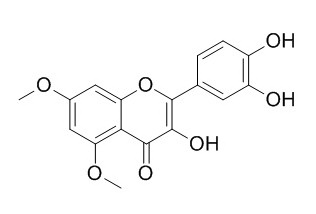5,7-Di-O-methylquercetin
5,7-Di-O-methylquercetin is a genotoxic compound from S. skinneri.
Inquire / Order:
manager@chemfaces.com
Technical Inquiries:
service@chemfaces.com
Tel:
+86-27-84237783
Fax:
+86-27-84254680
Address:
1 Building, No. 83, CheCheng Rd., Wuhan Economic and Technological Development Zone, Wuhan, Hubei 430056, PRC
Providing storage is as stated on the product vial and the vial is kept tightly sealed, the product can be stored for up to
24 months(2-8C).
Wherever possible, you should prepare and use solutions on the same day. However, if you need to make up stock solutions in advance, we recommend that you store the solution as aliquots in tightly sealed vials at -20C. Generally, these will be useable for up to two weeks. Before use, and prior to opening the vial we recommend that you allow your product to equilibrate to room temperature for at least 1 hour.
Need more advice on solubility, usage and handling? Please email to: service@chemfaces.com
The packaging of the product may have turned upside down during transportation, resulting in the natural compounds adhering to the neck or cap of the vial. take the vial out of its packaging and gently shake to let the compounds fall to the bottom of the vial. for liquid products, centrifuge at 200-500 RPM to gather the liquid at the bottom of the vial. try to avoid loss or contamination during handling.
Agriculture.2022, 12(3), 342.
Curr Eye Res.2018, 43(1):27-34
Food Structure2023, 36:100324.
J AOAC Int.2021, 104(6):1634-1651.
Malaysian Journal of Analytical Sciences2023, 27(4):840-848.
Plants (Basel).2021, 10(11):2317.
J Ethnopharmacol.2019, 228:132-141
Buildings2023, 13(5), 1112.
Acta horticulturae2017, 1158:257-268
Evid Based Complement Alternat Med.2015, 2015:165457
Related and Featured Products
Mutat Res. 1978 Dec;54(3):297-309.
Mutagenicity of plant flavonoids: structural requirements for mutagenic activity in Salmonella typhimurium.[Pubmed:
368618]
METHODS AND RESULTS:
40 compounds structurally related to the plant flavonol quercetin were tested for mutagenic activity in Salmonella typhimurium strain TA98. 10 flavonols, quercetin, myricetin, rhamnetin, galangin, kaempferol, tamarixetin, morin, 3'-O-methylquercetin, 7,4'-di-O-methylquercetin and 5,7-di-O-methyl-quercetin, exhibited unequivocal mutagenic activity.
CONCLUSIONS:
4 compounds, quercetin, myricetin, rhamnetin and 5,7-Di-O-methylquercetin, were active without metabolic activation, although metabolic activation markedly enhanced their activity.
Altern Lab Anim. 2002 Jan-Feb;30(1):87-92.
Use of the SOS-chromotest spot assay as a screening system for detecting genotoxic compounds in crude plant extracts.[Pubmed:
11827573]
METHODS AND RESULTS:
An SOS-chromotest spot assay was used to detect genotoxic compounds in crude plant extracts. The method allows simultaneous testing of extracts from different species in either a liquid or a solid crystalline form. Extracts from two species of the genus Senna, native to the state of Morelos, Mexico, were assayed. Four genotoxic compounds were isolated, and were identified as quercetin and rutin from S. wislizeni, and 5,7-di- O-methylrutin and 5,7-Di-O-methylquercetin from S. skinneri.
CONCLUSIONS:
The SOS-chromotest spot assay proved to be useful for activity- guided fractionation at the beginning of screening for genotoxic compounds in crude plant extracts.



